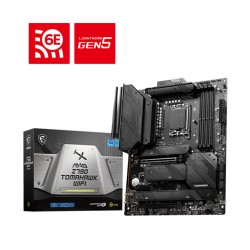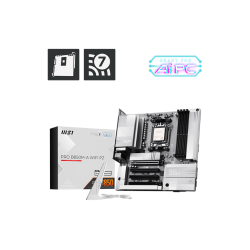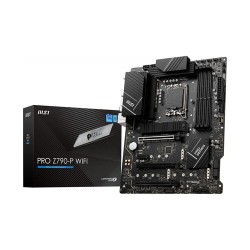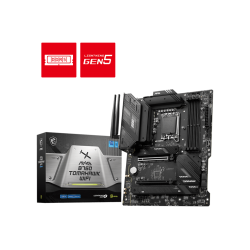Motherboard Price in Bangladesh – Get the Best Offers Today
A computer’s motherboard is typically the largest printed circuit board in a machine’s chassis. It distributes electricity and facilitates communication between and to the central processing unit (CPU), random access memory (RAM), and any other computer hardware component. There is a broad range of motherboards, each of which is intended to be compatible with a specific model and size of the computer. Since different kinds of processors and memories are designed to function best with certain types of motherboards, it is difficult to find a motherboard that is compatible with every type of CPU and memory. Hard drives, on the other hand, are generally compatible with a wide variety of motherboards and may be used with most brands and types.
Are you searching to buy a motherboard for your next project? All you have to do is check out UCC! We are the one-stop shop for all things computer-related in Bangladesh. This article will discuss the latest prices of Motherboards in Bangladesh, along with the features and technical specifications of these motherboards and the benefits of purchasing from UCC rather than other retailers.
Latest Motherboards Prices in Bangladesh
We offer the latest motherboard prices in Bangladesh. We understand that price is a major factor in purchasing computer hardware, so we offer competitive prices on all our products. Whether you're looking for a budget-friendly option or a high-end motherboard, we have something for everyone.
The prices of these Motherboards range from 7,000 BDT to 159,900 BDT, depending on the model and its features. We also offer regular discounts and promotions on our products, so be sure to check our website for the latest deals.
Best Motherboard Brands
Whether you opt for an Intel or AMD CPU for your desktop PC, selecting a quality motherboard from a reputable brand is crucial. A motherboard from a well-known brand can greatly influence your system's performance, whether it's for gaming or professional work. Popular brands Colorful and MSI offer a diverse range of motherboards suitable for various PC builds, from basic workstations to high-performance gaming rigs. With a plethora of options available, you can find the perfect motherboard to meet your specific needs and maximize your system's potential.
MSI Motherboard
An MSI motherboard is a high-performance circuit board designed to support MSI's range of CPUs, memory, and other components. Known for their durability and advanced features, MSI motherboards offer robust build quality, superior cooling solutions, and cutting-edge technology. They often include support for overclocking, high-speed connectivity, and gaming enhancements, making them ideal for both gamers and professionals seeking reliable and powerful computing solutions. The price of MSI motherboards in Bangladesh typically ranges from BDT 10,000 to BDT 30,000, depending on the model and features such as chipset, form factor, and additional functionalities. Prices may vary by retailer and promotions, with options available for both budget and high-performance builds.
Type of Motherboard
There are various kinds of motherboards, each serving a specific purpose. ATX motherboards are perfect for high-performance configurations because they provide a wide range of expansion options. For enthusiasts, extended ATX (E-ATX) boards offer even more room and functionality. Micro ATX is a more affordable option with decent expandability. The smallest, Mini ITX, is ideal for modest projects with constrained space.
ATX (Advanced Technology eXtended) motherboard
ATX is a widely embraced motherboard standard known for its well-defined size and layout. The framework offers an array of connectors catering to diverse components, which makes it a staple in conventional desktop computers and workstations.
- The most commonly used motherboard for desktop computers.
- It supports multiple expansion slots, such as PCIe for graphics cards, sound cards, and other peripherals.
- They offer a high number of RAM slots, USB ports, and SATA connections for storage.
- They are ideal for gaming rigs, workstations, and general-purpose PCs where expandability and performance matter.
Extended ATX motherboard
The extended ATX motherboard is more significant than the regular one. It has more space to add extra parts and cool features. It uses in powerful computers that need many graphics cards and storage.
- A larger and more advanced version of the ATX motherboard, used for high-performance systems like gaming PCs, workstations, and server builds.
- Measures 12 x 13 inches, providing even more room for additional components such as extra PCIe slots, RAM slots, and enhanced cooling options.
- Ideal for users who need extreme performance and future expandability.
Mini ITX Motherboard
It is a miniature version of a motherboard that was designed in the 2000s and is mainly used in small form factor computers. The reason behind its use is its faster cooling ability and low power consumption. It is one of the most preferred types of motherboard that is preferred in home theater due to its low level of fan noise. These primarily appeal to industrial and embedded PC markets with the majority sold as bulk components. These are produced with a longer sales life-cycle than consumer code which is a quality that industrial users require.
- A compact motherboard that is perfect for small form factor (SFF) builds.
- Measures 6.7 x 6.7 inches, making it ideal for compact or portable computers.
- Due to its small size, it has limited expansion slots (usually just one PCIe slot for a GPU), but it supports all modern components like high-speed RAM and storage.
- Popular in HTPC (Home Theater PCs) and compact gaming builds where space is at a premium.
Micro ATX motherboard
The length and width of these motherboards, measured in millimeters, are also 244 mm (size metrics will differ as per the manufacturer). This motherboard has fewer ports and slots than the Standard ATX board. Users who do not want excessive connections and subsequent upgrades, like adding more RAM, an extra GPU, or other Peripheral Component Interconnect (PCI) cards, are better suited for this kind of motherboard than others. This motherboard may be installed in any case with enough space to accommodate 244 mm by 244 mm. It can also be installed in larger cases that are compatible with Standard ATX or eXTENDED ATX motherboards.
- A smaller variant of the ATX motherboard, measuring 9.6 x 9.6 inches, compared to the standard ATX size of 12 x 9.6 inches.
- It typically features fewer PCIe slots and fewer expansion options but still retains sufficient functionality for most users.
- Great for budget builds and smaller systems without sacrificing too much in terms of performance.
How to Choose the Best Motherboard
When choosing the best motherboard, consider factors like compatibility with your CPU, RAM capacity, expansion slots, and connectivity options. Focus on the chipset, form factor (ATX, microATX), and features such as Wi-Fi and overclocking support for optimal performance.
Features of Motherboards
- It is important to choose a motherboard with a CPU socket that accommodates your choice of CPI.
- The motherboard has minimal impact on the performance of a computer.
- The chipset on the motherboard determines the speed with which the computer can run.
- Different types of motherboards have three types of slots. Memory slots allow you to plug RAM modules into the computer. With more slots, you can add more memory. These slots are specific to RAM type.
- Motherboards consist of both internal and external connectors. Some types of motherboards come with support for USB 3.0, graphic connectors, external eSATA, and legacy ports for parallel and serial connectors.
- Some types of motherboards use multiple hard drives together in a special configuration.
Buying Guideline For Motherboard in Bangladesh
- CPU sockets (or CPU slots) in which one or more microprocessors may be installed. In the case of CPUs in ball grid array packages, such as the VIA Nano and the Goldmont Plus, the CPU is directly soldered to the motherboard.
- Memory slots into which the system's main memory is to be installed, typically in the form of DIMM modules containing DRAM chips. Can be DDR3, DDR4, DDR5, or onboard LPDDRx.
- The chipset which forms an interface between the CPU, main memory, and peripheral buses
- Non-volatile memory chips (usually flash memory in modern motherboards) containing the system's firmware or BIOS
- The clock generator which produces the system clock signal to synchronize the various components
- Slots for expansion cards (the interface to the system via the buses supported by the chipset)
- Power connectors, which receive electrical power from the computer power supply and distribute it to the CPU, chipset, main memory, and expansion cards. As of 2007, some graphics cards (e.g. GeForce 8 and Radeon R600) require more power than the motherboard can provide, and thus dedicated connectors have been introduced to attach them directly to the power supply.
- Connectors for hard disk drives, optical disc drives, or solid-state drives, typically SATA and NVMe
Memory Type of Motherboard
When selecting a motherboard, the type of memory (RAM) it supports is a crucial factor. DDR5 motherboards and DDR4 motherboards represent the latest and previous generations of memory technology, respectively.
DDR5 Motherboard
Designed to support DDR5 RAM, these motherboards offer improved speed, efficiency, and capacity compared to DDR4. DDR5 RAM allows for higher bandwidth and more data transfer rates, making it ideal for gaming, content creation, and multitasking. It also supports greater power efficiency and higher module capacities, making it future-proof for demanding applications.
DDR4 Motherboard
While DDR4 motherboards are more affordable and widely available, they support the older DDR4 RAM. DDR4 still offers great performance for standard computing tasks, gaming, and productivity but lags behind DDR5 in terms of speed and scalability.
Choosing a Motherboard
The Motherboards can be mounted on Small towers, Mid-Tower, or Full Tower casing whether it’s an ATX, Micro-ATX, Mini-ATX, or iATX board. PCIe is the component connection port used by motherboards. The newest standard is PCIe 3.0 and 4.0. with x1, x4, x8, and x16 slots. Many motherboards have advanced features like integrated WiFi. RAMs are plugged into a motherboard via a rectangular slot called the dual in-line memory module (DIMM). The number of DIMM slots commonly varies from two to eight slots. The supported capacity for RAM ranges from 2GB up to 64GB DIMMs. Motherboards support a hard disk drive (HDD) with spinning platters and solid-state drives (SSD) with NAND flash memory for storage.
Gaming Motherboard
The worthiness of investing in a gaming motherboard hinges on factors such as specific needs, preferences, and budget. Gaming motherboards are more expensive than their regular counterparts but have specialized features, offer more expansion options, excellent audio quality, and are aesthetically pleasing.
Nonetheless, it’s imperative to remain money-conscious, so when operating on a tight budget and unsure of whether these gaming-specific features are helpful, a regular motherboard might offer better value. Although the motherboard for a gaming PC is essential to consider, the CPU and GPU often influence gaming performance more than the motherboard itself.
How does a motherboard work?
When you turn your computer on, the power supply transfers electricity to the motherboard to be used by the computer. Data is transported between the chipset components via data buses and travels between the Southbridge and Northbridge sections. The data connections to the CPU, RAM, or PCIe are made through the Northbridge component. The operations performed by the RAM are first “interpreted” by the CPU as being output after the RAM begins to deliver inputs to the CPU. After being written to the PCIe, the data is either copied or moved to the expansion card, based on the kind of card you have. The data connection to the basic input/output system (BIOS), the universal serial bus (USB), the serial advanced technology attachment (SATA), and the PCI bus are managed by the Southbridge component. Your computer can start up because of signals sent to the BIOS, and the data sent to the SATA awakens your optical, hard disc, and solid-state drives. The video card, network card, and sound card receive power from the information stored on the SATA. The remaining components interact via an electrical signal, which serves as a hub for them. These data buses pass via a microchip’s northbridge or southbridge elements, which then branch off to other components like the CPU, RAM, PCI, and PCIe, amongst other elements.
Why Choose UCC for Your Motherboard Purchase?
We are committed to providing our customers with a seamless and hassle-free shopping experience. We offer a wide selection of Motherboards from top brands at competitive prices, and our customer support team is always ready to assist you.
In addition to Motherboards, we also offer a wide range of computer hardware and accessories, including Motherboards, graphics cards, RAM, storage devices, power supplies, cooling solutions, gaming peripherals, and more. We offer products from top brands like MSI. If you're in the market for Motherboards in Bangladesh, look no further than UCC. We offer a wide selection of Motherboards from top brands at competitive prices, and our customer support team is always ready to assist you. Browse our selection of products today and experience a seamless and hassle-free shopping experience!
FAQs
1. Can I upgrade just my motherboard without changing other parts?
Yes, but it depends. If your CPU, RAM, and storage are compatible with the new board, you’re good. If not, you may need to upgrade those too.
2. How do I know if my motherboard is dead?
If your PC won’t turn on, shows no lights, no beeps, or doesn’t POST, your motherboard might be the culprit.
3. Is it better to go with Intel or AMD motherboards?
Both are great. Choose based on your CPU preference, performance needs, and budget.
4. What is BIOS and why is it important?
BIOS is the basic software on your motherboard that helps start your computer and manage hardware settings.
5. How long does a motherboard typically last?
With proper care, a good motherboard can last 5-10 years. However, new tech may make you want to upgrade sooner.




















